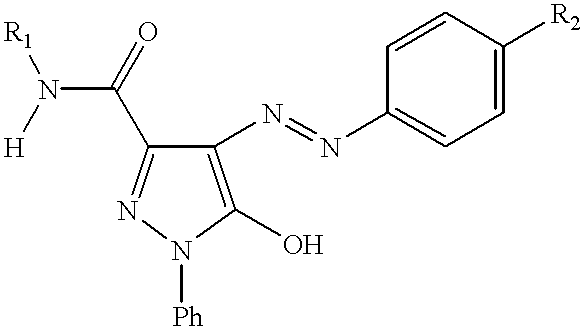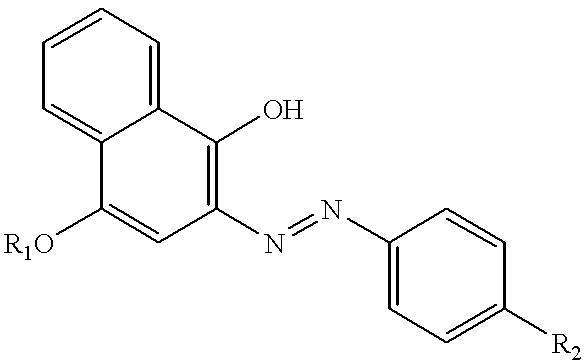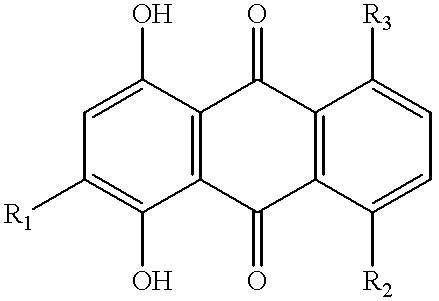Thermal transfer recording system
a recording system and thermal head technology, applied in the field of thermal head recording system, can solve the problems of limiting the printing speed of the thermal head, unsuitable high energy input, poor image durability, etc., and achieve the effect of low volatility and low viscosity
- Summary
- Abstract
- Description
- Claims
- Application Information
AI Technical Summary
Benefits of technology
Problems solved by technology
Method used
Image
Examples
example 1
This example illustrates that a wide variety of commercially available and synthetic dyes can form a non-tacky, amorphous solid film suitable for use in the present invention. Commercially-available and custom-synthesized yellow, magenta, cyan and black dyes were screened for amorphous solid film formation in the following manner:
A 5% w / w solution of the test dye in 2-pentanone or 1-butanol was coated onto poly(ethyleneterephthalate) film base of 1.75 mil (44.5 .mu.m) thickness with a #6 Meyer rod. The coating was dried with warm air and tested after 24 hours for crystallization (using polarized light microscopy), abrasion resistance (using a rub test), and tack. The following materials showed no detectable crystallization and passed the rub and tack tests (which were carried out, respectively, by rubbing a cotton swab across the surface of the solid film and by touching with a finger the surface of the solid film).
Color Index (C.I.) Solvent Yellow 13, C.I. Solvent Yellow 19, C.I. S...
example 2
In this example, there is illustrated a combination of a dye which does not itself form a stable amorphous solid layer with a non-dye component to form an amorphous solid thermal transfer material layer according to the invention. In this example yellow dye (XXV) and magenta dye (XXVI), respectively, were combined with non-dye component 1,3-di(4-pyridyl)propane.
Yellow Dye XXV, whose preparation is described in Example 4 below, was a crystalline solid as determined by X-ray powder diffraction conducted as described above with reference to FIG. 2.
The combination of yellow Dye XXV and 1,3-di(4-pyridyl)propane (which melted at 61.2.degree. C. as a pure material) was prepared by dissolving both materials in tetrahydrofuran, removing the solvent by vacuum evaporation under mild heating to produce a transparent yellow solid. The Tg of various combinations of these components (measured as described in Example 5) is shown in Table I.
In none of these mixtures was any crystalline dye or crysta...
example 3
In this Example, the preparation of some representative thermal solvents used in the present invention is described. TS1 and TS2 were obtained from Aldrich Chemical Company and used as received. TS6 was prepared as described in Sasin et al., J. Am. Oil Chem. Soc. 34, 358 (1957).
TS3 (See also J.Am.Chem.Soc. 110, 5143 (1988)).
6.9 grams (30 mmoles) of the 1,12-dodecanedioic acid was added to 40 mL of thionyl chloride, and the resulting suspension stirred with heating to reflux. After 30 minutes reflux the mixture became clear; over the course of an additional 30 min at reflux a faint yellow color was noted. Much of the excess thionyl chloride was removed by distillation (collected 22 mL). The residual pale yellow oil was diluted with 1,2-dichloroethane (30 mL), and distillation was resumed until an additional 30 mL had been collected. The residual oil was diluted with dichloromethane (25 mL) and added dropwise with stirring at ca. -10.degree. C. (dry ice / IPOH bath) to a stirred mixture...
PUM
| Property | Measurement | Unit |
|---|---|---|
| melting point | aaaaa | aaaaa |
| melting point | aaaaa | aaaaa |
| melting point | aaaaa | aaaaa |
Abstract
Description
Claims
Application Information
 Login to View More
Login to View More - R&D
- Intellectual Property
- Life Sciences
- Materials
- Tech Scout
- Unparalleled Data Quality
- Higher Quality Content
- 60% Fewer Hallucinations
Browse by: Latest US Patents, China's latest patents, Technical Efficacy Thesaurus, Application Domain, Technology Topic, Popular Technical Reports.
© 2025 PatSnap. All rights reserved.Legal|Privacy policy|Modern Slavery Act Transparency Statement|Sitemap|About US| Contact US: help@patsnap.com



